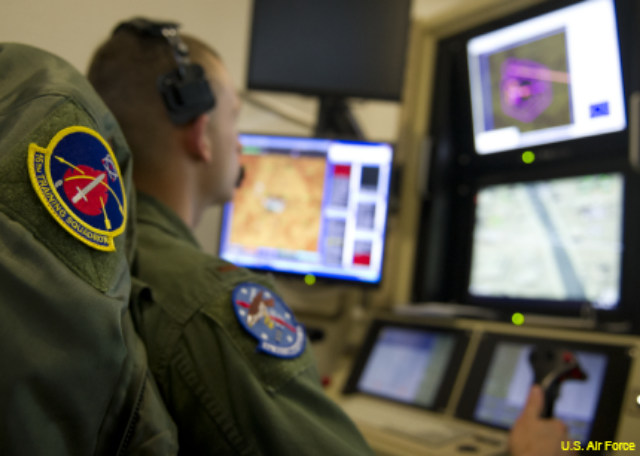The US Air Force is pursuing a range of options that will, in combination with a reset in the number of sustainable combat air patrols, help alleviate long-term stress on Remotely Piloted Aircraft crews.
Initial efforts were announced by the Air Force Secretary and Chief of Staff earlier this year; new initiatives include incentive pay increases and bonuses for crews, directing additional funds to the mission, augmenting current crew manning, increasing the number of RPA pilot graduates, and increasing the use of Guard and Reserve Airmen as well as contractors to bring relief to a community in high demand.
Air Force Secretary Deborah Lee James says the Air Force will continue to support Combatant Commanders with RPA missions while also focusing on initiatives that reduce stress on personnel and build readiness that is sustainable over time.
“Balancing ISR capability across the range of military operations with finite resources remains a challenge,” said Secretary of the Air Force Deborah Lee James. “In order to best meet mission demands and sustain the force, the SECDEF has approved a CAP reset to improve RPA pilot operations tempo. We needed to do this to ensure the long-term viability of this capability.”
After spending much of the last decade in surge mode, the Air Force is looking to put into place measures to bring additional relief to the high-demand remotely piloted aircraft community.
“What our Remotely Piloted Aircraft professionals are doing in today’s fight and in preparing for future conflicts is simply incredible,” said Gen. Hawk Carlisle, Air Combat Command commander. “RPAs fulfill critical demands in every theater 24 hours a day, 365 days a year.”
Operating at a surge capacity for nearly a decade has taken a toll on the force. In order to meet combatant commander requirements, and in response to SECDEF direction, the Air Force surged MQ-1/9 combat air patrols nine times in the last eight years, and has sustained those operations to date, according to Air Force officials.
In April, Secretary of Defense Ash Carter approved the reset of the CAP planning guidance to reflect a drop in CAPs from 65 to 60. This initiative was designed to alleviate the state of constant surge experienced by the RPA community.
Air Force leadership recognizes the stakes of not properly balancing mission demands against the needs to develop the force and the potential risk assumed in areas such as retention, training, manning, and combat capability.
“Maintaining operational success and fulfilling combatant command requirements for a sustained period of time has impacted our ability to train the force and risks the health and long-term viability of the enterprise,” said Gen. Mark A. Welsh III, Air Force Chief of Staff. “Current demand put requirements for active-duty RPA pilots at about 300 per year. However, our current active-duty training production output is only 180 pilots per year. The new plan aims to add more than 100 additional pilot graduates per year.”
To address concerns, the Air Force launched several initiatives in January 2015 to deal with the growing strain on RPA capacity and continues to explore options to fix manning challenges.
In January, Secretary James took immediate action to increase RPA pilot Aviation Pay from $650 to $1,500 a month. Now the service is developing plans for a longer-term RPA pilot retention bonus for Fiscal Year 2016 release and is actively advocating for new incentives.
“We’ve improved the Aviator Retention Pay bonus for traditional pilots flying RPAs, making their bonus consistent with other stressed rated officer communities,” said James. “We are also committed to improving Aviator Retention Pay bonuses for traditional pilots electing to fly RPAs.”
In order to enable force development and necessary training the Air Force will make use of an array of resources.
“In an effort to further improve the health of the force, we will leverage the Air Reserve Component (ARC) and contractor support to bring relief to the active-duty force. This will allow manning to be reinvested into the RPA training pipeline,” said James.
Additionally, to bring relief to the active-duty force, the Air Force plans to mobilize reserve component forces to take on three combat air patrols.
The service is also working on funding actions to relieve stress across the RPA enterprise. The Air Force recently moved $7.8 million into the RPA program to grow school house capacity, increase reserve component manpower augmentation days and contract some downrange and recovery efforts.
“We’re redirecting funds into the RPA community and will request support from within the Department of Defense to cover additional requirements,” said James. “This is an absolutely critical mission set and investment is required to ensure its long-term viability. We’re committed to getting this right.”
The service recognizes the demand for ISR and RPA pilot skills will remain.
“The demand for ISR capability will always exist,” said James. “We are focused on developing and managing ISR assets to be agile and responsive enough to support global and theater requirements in a seamless manner while at the same time, managing the stress on Airmen. We are taking action to provide near-term operational relief while addressing quality of life concerns.”
Source: Press Release

